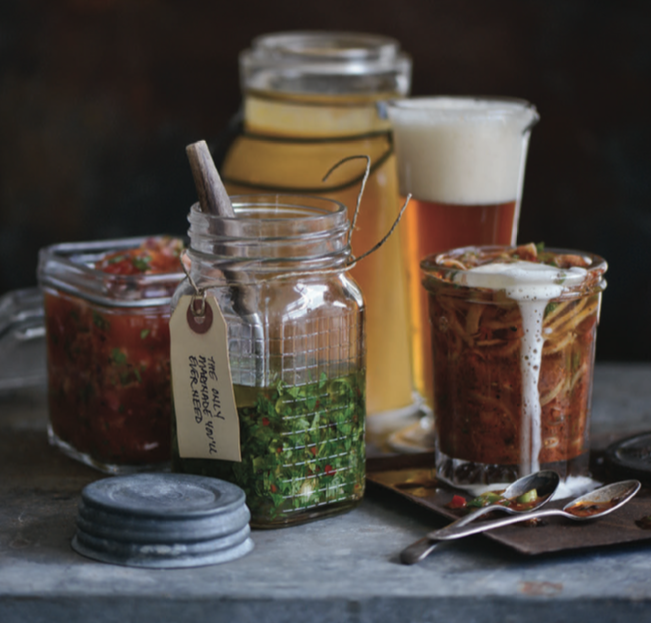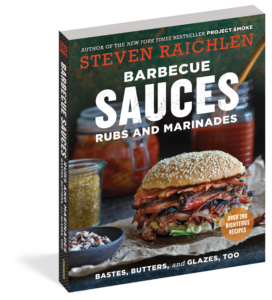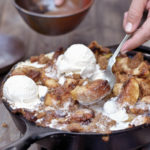Excerpted from Steven Raichlen’s Barbecue Sauces, Rubs, and Marinades.
Here’s a brief overview in order of when the components are used in the cooking process, along with some basic definitions. Note that there can be considerable overlap between categories: All wet rubs are marinades, for example, but not all marinades are wet rubs.

SEASONINGS
These are mixtures of salt and spices used to season foods before, during, and after grilling. Seasonings differ from rubs in that salt is always the primary flavoring and that they are applied just prior to and/or during the cooking.
RUBS
These are mixes of salt, spices, herbs, and often sugar or other sweeteners used to give a base flavor to the meat, rather than just season it. Rubs are usually applied to the meat several hours before cooking, so that a marinating effect takes place. Rubs help foster the formation of a savory crust.
DRY RUBS
These contain only dry ingredients. They are sprinkled over the food in powder form.
WET RUBS
Also known as spice pastes, these start as dry rubs, but a liquid—often water, oil, or yogurt—is added to create a thick paste. This paste is smeared on the meat, where it works in a way similar to a marinade.
MARINADES
These are liquid seasonings—mixtures of herbs, spices, aromatic vegetables (such as garlic, onions, and peppers), and flavorful liquids (such as olive oil, lemon juice, soy sauce, vinegar, or yogurt). The essence of a marinade is its wetness: The meat acquires its flavor by means of soaking. Marinades benefit meats in ways other than adding flavor. The acids in the marinade (wine, lime juice, vinegar) tenderize the meat by breaking down muscle fibers. The oil and other liquids keep the meat moist during cooking. Thus, marinades are particularly well suited to lean, dry meats, such as chicken breasts and game.
BRINES
Brines are saline (salt water) solutions used for marinating and curing. (Sometimes sugar is added, too.) The typical salinity is 6 to 7 percent. Brines are used to make bacon, ham, jerky, and kippered salmon, and they’re also useful for keeping intrinsically dry meats, like turkey or pork chops, from drying out on the grill.
CURES
Like brines, cures have a high salt content. (The salt “cures” the meat by drawing out moisture. It also imparts a pleasing flavor all its own.) Cures often contain sugar and spices. Unlike brines, they’re dry instead of wet.
BASTES
Liquids applied to foods as they cook are called bastes. Basting serves three purposes: It keeps meats moist, adds an extra layer of flavor, and fosters the formation of a savory crust during grilling. A baste can be as simple as apple cider sprayed on ribs with a mister or as elaborate as the lemon-saffron-butter mixture brushed on shish kebab by Iranian grill jockeys. Bastes usually contain some sort of fat—olive oil or melted butter, for example—to keep the meat moist.
FLAVORED OILS
Often used for basting, flavored oils can also serve as marinades, sauces, and decorative drizzles.
GLAZES
Similar to bastes in that they are brushed on the food as it cooks, glazes are applied toward the end of cooking to create a shiny coating. Most contain a sweetener, like sugar or honey, which caramelizes during the cooking process, creating a sweet, flavorful exterior.
FINISHING SAUCE
A uniquely American invention, a finishing sauce is brushed on meat at the end of or after cooking to keep it moist and flavorful until serving. Finishing sauces are usually found on the barbecue competition circuit, where the meat must travel from the pit to the judging station.
BARBECUE SAUCE
To many people, barbecue just isn’t barbecue without it. In the United States alone, there are thousands of commercially bottled barbecue sauces and dozens of regional styles. Barbecue sauces range from the sweet smoky red condiment of Kansas City to the mouth- puckering vinegar sauces of the Carolinas and the unusual white mayonnaise-based barbecue sauce in northern Alabama. Like Italy’s pasta sauces, barbecue sauces evolved to accompany a specific kind of meat. South Carolina’s sharp mustard sauce, for example, counterbalances the fat in a barbecued pork butt. The watery thinness of North Carolina vinegar sauce allows it to be readily absorbed by the pulled (shredded) pork so popular in this region. This book includes a full chapter of American barbecue sauces and another full chapter of the barbecue sauces popular elsewhere in the world.
SLATHER SAUCE
This catchall category includes condiments that are slathered or spread on grilled fare and barbecue before serving. Ketchup and mustard are slather sauces; so are mayonnaise, aïoli (a creamy garlic sauce from Provence), and romesco (Spanish roasted vegetable and nut sauce). Slather sauces are generally thicker than conventional barbecue sauce. (The exception here is ketchup.) Many contain eggs, oil, or cream: Think tartar sauce, horseradish sauce, or béarnaise sauce.
DIPPING SAUCE
A condiment you dip cooked barbecue into. Thai peanut sauce is one of the quintessential dipping sauces; so are Vietnamese nuoc mam and Kentucky black dip. While you find dipping sauces in many parts of the world, Southeast Asia is their epicenter. This makes sense, because for Southeast Asians, barbecue means tiny kebabs and paper-thin slices of meat, which are just perfect for dipping in tiny bowls of flavorful sauce.
CONDIMENTS
Salsas, relishes, pickles, chutneys, and other intensely flavorful accompaniments companion barbecue the world over. As a rule, condiments are too thick to qualify as sauces. They’re served a spoonful at a time with simply grilled meats and seafood. Their explosive flavors round out the barbecue experience, particularly in Mexico, India, and Asia.
SALSA
This vibrant Mexican table sauce accompanies barbecue south of the border. Mexican salsas come in a dazzling variety—from the simple salsas frescas of northern Mexico to the robust roasted chili and vegetable salsas of Oaxaca and the Yucatán. Mexican salsa inspired many of the fruit salsas served with simple grilled poultry and seafood at contemporary restaurants in North America.
RELISH
Mixtures of chopped vegetables or fruits, relishes are often pickled or seasoned with vinegar and sugar. The sharpness of vinegar or citrus juice in a relish counterpoints the smoke flavor of grilled fare.
CHUTNEY
“A strong, hot condiment compounded of ripe fruit, acids, or sour herbs, and flavored with chiles and spices” is how the Oxford English Dictionary defines chutney. That pretty much sums it up, except to say that chutneys were born in India, where they are still traditionally served with curries, stews, and rice dishes. Spoon chutney over a simple grilled salmon steak or chicken breast and you’ll see dinner from an entirely new perspective.
Think you know it all? Test your sauces and marinades IQ here.
 About the Book:
About the Book:
Barbecue sauces, rubs, and marinades are every griller’s secret weapon—the flavor boosters that give grilled food its character, personality, depth, and soul.
Steven Raichlen, America’s “master griller” (Esquire), has completely updated and revised his bestselling encyclopedia of chile-fired rubs, lemony marinades, buttery bastes, pack-a-wallop sauces, plus mops, slathers, sambals, and chutneys. It’s a cornucopia of all the latest flavor trends, drawing from irresistible Thai, Mexican, Indian, Cajun, Jamaican, Italian, and French cuisines, as well as those building blocks from America’s own barbecue belt.
There are over 200 recipes in all, including a full sampler of dinner recipes using the sauces. And the book now has full-color photographs throughout. It’s the essential companion cookbook for every at-home pitmaster looking to up his or her game.
Buy the Book
Indiebound | B&N | Amazon | Workman





No Comments